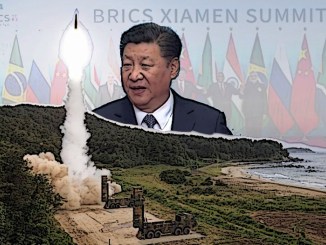
All you need to know about this year’s BRICS Summit in Xiamen, China
-fearless, unabridged, and uncensored / via New Delhi Times
1. Mexico and Co.
Yes, the five BRICS nations—Brazil, Russia, India, China, and South Africa—invite observer nations and possible future candidates such as Mexico… BRICS-MEX? Egypt is another future hopeful.
2. BRICS in numbers
BRICS is a 3 billion footmen strong global force. Together they produce ¼ of global GDP and accounted for ½ of global growth in 2016.
3. The Doklam standoff
The Chinese call is ‘Dong Lang’. Last month, the Chinese built a road in a territory that allegedly belongs to Bhutan—a small Himalayan state bordering also on Chinese Tibet. The Indian army dispatched troops, crossing into Chinese territory. That was it. The Western media cried war, but the two, three countries dissolved the standoff…for now. Versions differ. The Chinese say the Indian army retreated. The Indians say the Chinese withdrew.
4. Anti-Western rhetoric
Damn right there is so-called anti-Western rhetoric in the BRICS media. That said, the much more influential Western media is partly to blame. Western liberal media subvert their own US president, subvert their own race, subvert their own culture. No surprise, then, that Western press soldiers target anything BRICS does. Just this morning I read British Guardian: “dark shadows over BRICS”. And US Fox News: “BRICS and stones may break our loans.” And French AFP: “Common ground in short supply at BRICS meeting.” That said, with so much Western ill-will, BRICS must be doing something right.
5. BRICS strategy
This 2017 BRICS 9th Annual Summit in Xiamen, China, is the largest of BRICS meetings, but it is not the only one. There are dozens more meetings scattered all over the globe that do not get as much media coverage but are nevertheless progressive. For example, the ‘Meeting of the National Security Advisers’ took place on 27/28 of July in Beijing last week. That was mainly about security issues. Then, there was a ‘BRICS informal meeting’ in July in Hamburg during the G20 summit in Germany. Next there will be the ‘Foreign Affairs & International Relation’ meeting in September in New York. So, what official statement we hear during the summit in Xiamen is largely a summary and grand showmanship.
6. North Korean missiles
The testing of yet another nuclear bomb by North Korea prior to the BRICS summit in China is clear attention seeking and calculated by the DPRK regime as a distraction away from a BRICS summit that is, above all, dedicated to global peace and stability. More I don’t want to say. This is the world we are living in, and we must focus on the good of men.
7. Problems of BRICS
The five BRICS countries have different economies and political systems, but mutual goals. Much like Joe and his wife. It’s workable. The BRICS establishment of the ‘New Development Bank in 2016 should be seen a major success of which, for example South Africa profits in terms of new infrastructure projects. As to trade relations, Brazil is undertaking a large privatization of some airports and ports and hopes to attract Chinese investors. Russia doesn’t believe just yet in the so-called ‘post-oil economy’ preached in the Western press, so it is going to profit from oil and other natural exports.
8. China’s hegemony
One thing I would like to clarify here. China is the world’s largest economy. It surpassed the United States in terms of GDP (PPP) already in 2013, according to the CIA Fact book, the World Bank, and the International Monetary Fund. Even our milk cows in Germany have heard China is number one, with a 21 trillion dollar economy [the USA: 19 trillion; the EU: 18 trillion]. And, yes, China became the world’s largest trading nation (in terms of goods) by 2014. The Western press, in concert, is still propagating the US as the champion, of course. Fake news.
9. India’s troubles
India’s president Modi speaks English, not Hindi, which always amazes me considering the history of India. He is under pressure in India to neutralize the new hegemony of China. Take the so-called ‘China-Pakistan corridor’. China and Pakistan engage in huge bilateral trade deals which, among other, grant China access to Pakistani ports with access to the Indian Ocean. Other problems include a tide of terrorism and separatist movements in the region. India is largely a Hindu nation while Pakistan is largely a Muslim nation. Ethnic and religious clashes are common.
10. BRICS future outlook
Xi Jinping in his opening speech laid out the future plans of BRICS:
- Boost BRICS cooperationwith a focus on long term goals.
- Global responsibility in peace and stabilitywith focus on “multilateralism” and “greater democratization” (in Chinese: minzhuhua) in international relations.
- Global economic governance, open world economy, and trade liberalization (as opposed to rising US and EU protectionism).
- Expand influence of BRICS. In Xi’s own words: It is “Easy to break 1 arrow, but hard to break a bundle of them.”
Which reminds me that “BRICS” is not the Chinese name for BRICS. The Chinese name for BRICS is ‘jin zhuan’. It means Gold Bricks.
Thorsten J. Pattberg, German philosopher and cultural critic
This article was first published on September 5, 2017, by the New Delhi Times.
